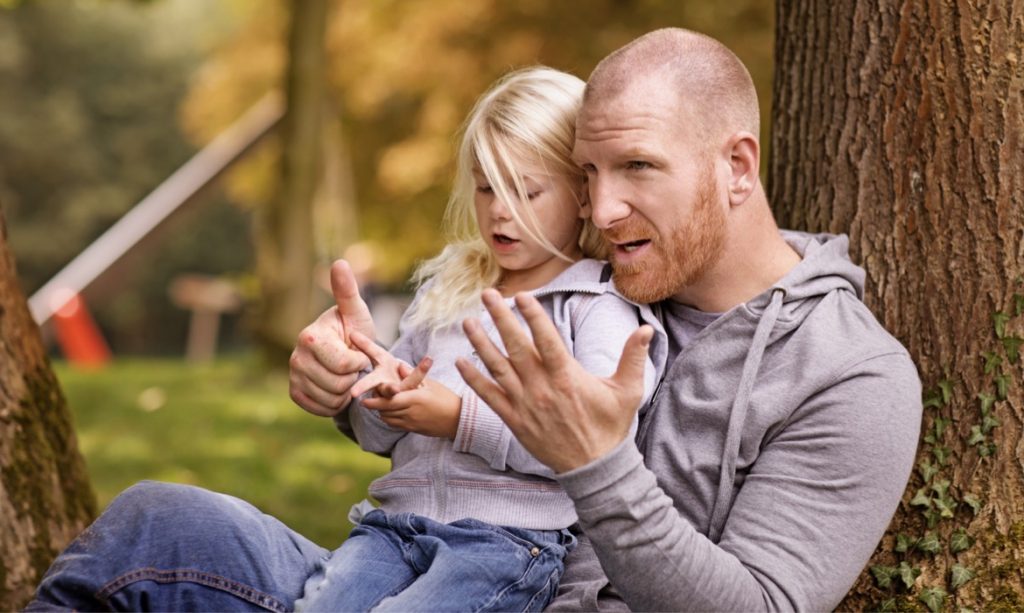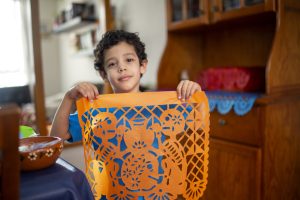- Counting on fingers is an effective strategy to support children’s early math learning.
- Many children can represent numbers on their fingers before they can say the corresponding number word.
- There are fun, easy finger-counting activities that families can do to deepen children’s understanding of early math concepts.
Priya is completing an addition worksheet. She is stuck on the problem 5+3 so she decides to use her hands to help her figure out the answer. She holds up five fingers on one hand and counts to three while one-by-one raising three fingers on the other hand. Priya then counts all of her outstretched fingers. “Eight!” she says and moves on to the next problem.
Priya struggled to answer the math problem but she cleverly used a tool that’s available at her fingertips (literally!) to solve the problem.
It is a common myth that counting on fingers is an immature math strategy and hinders children’s learning. However, research shows that using fingers to help teach early math concepts supports children’s math learning. [1,2,3] In fact, using fingers or other body parts to count may be the oldest and most widespread number representation system in the world. [4]
When teaching counting, early childhood educators often use objects such as animal counters, base-10 blocks, or linking cubes. These objects, or manipulatives, can help make abstract math concepts and procedures more concrete and easier to understand. [5] Fingers can work in the same way—plus they have the advantage of almost always being available.
For an example of finger counting in action, watch this short video of a 2-year-old using materials readily available to him—his fingers—to practice counting his baby brother’s fingers.
Counting on Fingers Helps Children Practice and Understand:
The order of the number counting list. Raising a finger for each number in the list not only reinforces that four comes after three, but also that four is exactly one more than three. [1]
The base-10 number system. Counting on fingers reminds children that each decade (20, 30, etc.) has the same pattern, repeating the numbers one through nine before the decade name changes. [2,6]
The counting-on addition strategy. Priya practiced this in the example above when she counted to one number and added more numbers to find the total. [3]
Counting on Fingers Also Helps Children Understand the Meanings of Symbolic Number Words Assigned to Quantities

Fingers can also be used to label set sizes. Have you ever noticed that sometimes children will respond to the question, “How old are you?” by silently holding up the correct number of fingers? This may be because young children find hand gestures easier to produce and understand than spoken or written number words. [7]
For example, the word two does not have any inherent two-ness about it. As English-speaking adults, we know what twomeans because we have collectively agreed that this particular combination of sounds and letters symbolizes two entities. Now imagine two outstretched fingers. This gesture inherently captures two-ness in that there are exactly two fingers raised. Pairing gestures with speech can be a powerful tool to help children understand the meanings of symbolic number words assigned to quantities.
This gesture inherently captures two-ness in that there are exactly two fingers raised. Pairing gestures with speech can be a powerful tool to help children understand the meanings of symbolic number words assigned to quantities.
Finger Counting is Backed by Brain Research

The brain has networks that control our physical finger movements. It also has networks that mentally perceive and represent our fingers. This network is activated when adults and children perform math problems, even if they are told to keep their hands still. [8,9]
Moreover, children who have better finger sense—the ability to mentally represent individual fingers—also perform better on symbolic math assessments. [10,11,12]
There are many fun activities that can improve children’s finger sense and, in doing so, also improve their math abilities. [13]
Finger Counting Activities
Research shows that both seeing and hearing information can make difficult concepts easier to grasp. [14] Here are easy ways to incorporate finger counting into everyday conversations with young children:
- Anytime you say a number word, you have the opportunity to pair it with a number gesture. When you count out loud to your child or label a set size with a number word, demonstrate with your fingers as well. Parents who use more number gestures have children who use more number gestures. [15]
- You can bolster the connection between gestures and words by encouraging your child to use both. For example: “Show me with your fingers how many crackers you have. Now tell me how many crackers you have.”
- Encourage children to represent numbers in whatever way is comfortable for them. Some children struggle to arrange their fingers in specific ways; for example, three and four are particularly tricky. Young children could instead represent three in an unconventional way, such as raising one finger on the left hand and two fingers on the right. You can play games asking your child how else they could show three fingers.
- Make a game of counting together. Have your child be the verbal counter and you be the finger counter. As you raise each of your fingers, your child says the corresponding number word. Take turns in each counting role.
- Improve finger sense by doing finger-based activities. Use stickers or markers to put a colored dot on each of your child’s fingernails. Draw a maze using different colored pathways (see an example below). Have your child trace each path with the matching colored finger.

[1] Wiese, H. (2003). Numbers, Language, and the Human Mind. Cambridge: Cambridge University Press.
[2] Domahs, F., Moeller, K., Huber, S., Willmes, K., & Nuerk, H. C. (2010). Embodied numerosity: implicit hand-based representations influence symbolic number processing across cultures. Cognition, 116(2), 251-266.
[3] Fuson, K. C. (1982). An analysis of the counting-on solution procedure in addition. Addition and subtraction: A cognitive perspective,67-81.
[4] Ifrah, G. (2000). The Universal History of Numbers: From Prehistory to the Invention of the Computer, translated by David Vellos, EF Harding, Sophie Wood and Ian Monk.
[5] Carbonneau, K. J., Marley, S. C., & Selig, J. P. (2013). A meta-analysis of the efficacy of teaching mathematics with concrete manipulatives. Journal of Educational Psychology, 105(2), 380.
[6] Andres, M., Di Luca, S., & Pesenti, M. (2008). Finger counting: The missing tool?. Behavioral and Brain Sciences, 31(6), 642-643.
[7] Gunderson, E. A., Spaepen, E., Gibson, D., Goldin-Meadow, S., & Levine, S. C. (2015a). Gesture as a window onto children’s number knowledge. Cognition, 144, 14-28.
[8] Dehaene, Stanislas, Nathalie Tzourio, Victor Frak, Laurence Raynaud, Laurent Cohen, Jacques Mehler, and Bernard Mazoyer. “Cerebral activations during number multiplication and comparison: a PET study.” Neuropsychologia34, no. 11 (1996): 1097-1106.
[9] Zago, L., Pesenti, M., Mellet, E., Crivello, F., Mazoyer, B., & Tzourio-Mazoyer, N. (2001). Neural correlates of simple and complex mental calculation. Neuroimage,13(2), 314-327.
[10] Fayol, M., Barrouillet, P., & Marinthe, C. (1998). Predicting arithmetical achievement from neuro-psychological performance: A longitudinal study. Cognition, 68(2), B63-B70.
[11] Noël, Marie-Pascale. “Finger gnosia: a predictor of numerical abilities in children?.” Child Neuropsychology11.5 (2005): 413-430.
[12] Berteletti, I., & Booth, J. R. (2015). Perceiving fingers in single-digit arithmetic problems. Frontiers in psychology, 6, 226.
[13] Gracia-Bafalluy, M., & Noel, M. P. (2008). Does finger training increase young children’s numerical performance?. cortex, 44(4), 368-375.
[14] Church, R. B., & Goldin-Meadow, S. (1986). The mismatch between gesture and speech as an index of transitional knowledge. Cognition,23(1), 43-71.
[15] Oswald, M., Gibson, D., Butts, J., Levine, S., & Goldin-Meadow, S. (March 2019) The Spontaneous Use of Cardinal Number Gestures.Paper presented at the 2019 Society for Research in Child Development Biennial Meeting, Baltimore, MA



